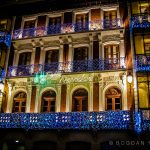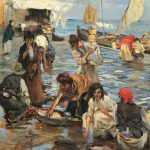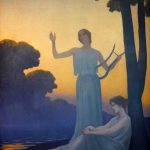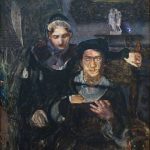Doménikos Theotokopoulos, famously known as El Greco, which means “The Greek” in Spanish, was born on the island of Crete in 1541, then part of the Republic of Venice. His early life in Crete, where he was initially trained in the Byzantine tradition of icon painting, laid the foundation for his unique artistic journey. El Greco’s work, characterized by elongated figures, dramatic spiritual expressions, and distinctive use of color and light, stands out as a bridge between the post-Byzantine and the Renaissance worlds, making him one of the most original artists of his time.
Seeking broader artistic horizons, El Greco left Crete in his mid-twenties, eventually making his way to Venice, the art capital of the world at the time. There, he was profoundly influenced by the works of Titian, Tintoretto, and other Renaissance masters, absorbing their techniques and the vibrant color palette that would become a hallmark of his style. However, it was in Venice that El Greco began to develop his distinctive approach, moving away from the naturalism of the Renaissance towards a more expressive, emotionally charged form of painting.
In 1570, El Greco moved to Rome, seeking the favor of the powerful Cardinal Alessandro Farnese. While in Rome, he studied the works of Michelangelo and Raphael, but his style diverged significantly from the prevailing trends of the Roman art scene. El Greco’s insistence on the primacy of color over form and his disregard for the classical proportions led to disagreements with other artists and limited his opportunities in Italy.
Undeterred, El Greco left Italy for Spain, eventually settling in Toledo in 1577. It was in Toledo that his artistic vision truly flourished. The city’s mystical atmosphere and the patronage he received there allowed him to create some of his most famous works, such as “The Burial of the Count of Orgaz,” “View of Toledo,” and “The Opening of the Fifth Seal.” These works are notable for their dramatic intensity, spiritual depth, and the elongated forms of their figures, which seem to stretch towards the divine.
El Greco’s unique approach to painting was not only a departure from the norms of his time but also a precursor to the expressionist and abstract movements that would emerge centuries later. His ability to convey emotion through color, light, and form influenced artists such as Picasso and Cézanne, who saw in El Greco a kindred spirit who prioritized emotional expression over realistic depiction.
Despite his significant contributions to the art world, El Greco’s work was somewhat forgotten after his death in 1614 and remained relatively obscure until the 19th century. The rediscovery of his paintings in the late 19th and early 20th centuries led to a reassessment of his place in art history, with critics and artists alike marveling at his ahead-of-his-time techniques and visionary approach.
Today, El Greco is celebrated as one of the most influential figures in Western art, a master who defied the conventions of his time to create works of profound emotional and spiritual depth. His paintings, with their unique blend of Byzantine and Western art traditions, continue to captivate viewers with their intensity and beauty, ensuring El Greco’s legacy as a pioneering artist whose work transcends the boundaries of time and tradition.





